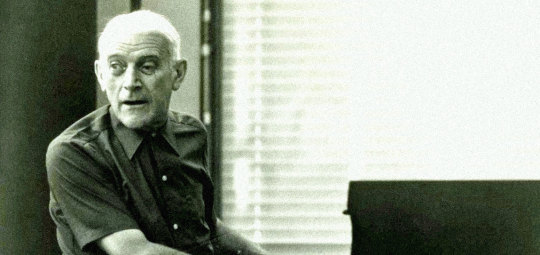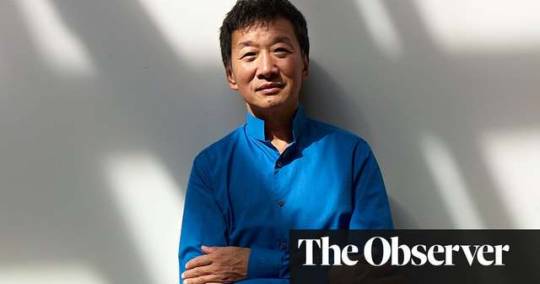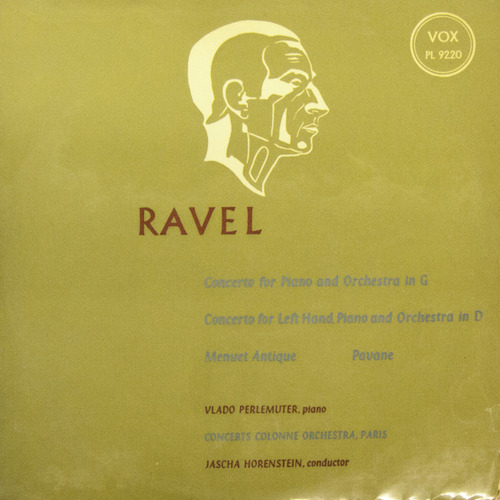#vlado perlemuter
Explore tagged Tumblr posts
Text
Vlado Perlemuter With Jean Martinon And The French Radio Orchestra In Concert - 1956 - Past Daily Weekend Gramophone
Vlado Perlemuter – revered – admired. Studied with Fauré and Ravel. https://pastdaily.com/wp-content/uploads/2023/11/Beethoven_Op37_Perlemuter_ONRDF-March-22-1956.mp3 Vlado Perlemuter with Jean Martinon and The French Radio Orchestra – March 22, 1956 – Radio France – Vlado Perlemuter in concert this weekend. From a broadcast over French Radio on March 22, 1956, Perlemuter is joined by Jean…

View On WordPress
0 notes
Text
Astrological Predictions and Character Analysis for Individuals with a May 26th Birthday
They are truly adept at offering their viewpoints recorded as a hard copy, they show creative or scholarly abilities. Somewhat haughty and egotistical: they are magnificent for mental works. They are particularly great at legitimizing the legitimacy of your cases. Diligent and steady in their contentions. Their inclination is for the most part very confrontational, they are likewise envious. They are not scared of dangers and betting. They are individuals of numerous gifts and double qualities. Their inward functions are unique in relation to what they show outwardly. Their states of mind are continually evolving. At the point when their lead is great, they are magnificent laborers and readily come to the guide of others. In any case, when they are feeling terrible, they are latent and detached. By and large, your circumstance is great. They lead their business with expertise and request. They focus on their way of behaving, appearance, and attire. They can depend on progress in military-related vocations. His siblings can get great positions. They put forth bold attempts to accomplish riches and a decent position. What undermines them: They can anticipate resistance, however they can likewise overcome their foes. Your life relies upon risk. Astrological Predictions and Character Analysis for Individuals with a May 26th Birthday
Assuming your birthday is on May 26, your zodiac sign is Gemini May 26 - character and character character: sympathetic, happy, inconspicuous, curt, anxious, inquisitive; calling: review or, turner, specialist; colors: olive, cream, beige; stone: cimfano; creature: turkey; plant: strawberry; fortunate numbers: 3,7,14,21,39,46 very fortunate number: 19 Occasions and observances - May 26 Poland: Mother's Day. Uruguay: Public Book Day. World Sherry Day. Guyana: Autonomy Day. Georgia: Autonomy Day. May 26 VIP Birthday. Who was conceived that very day as you? 1900: Lesley Selander, American movie producer (d. 1979). 1902: Jesდºs Pabდ³n, Spanish history specialist and legislator (d. 1976). 1903: Otto Abetz, German representative, envoy of Nazi Germany in France (d. 1958). 1904: Vlado Perlemuter, French piano player and instructor of Lithuanian beginning (d. 2002). 1907: John Wayne, American entertainer, vocalist, movie producer and maker (d. 1979). 1907: Joaquდn Gდ³mez Bas, Spanish writer (d. 1984). 1908: Adolfo Lდ³pez Mateos, Mexican legislator, president somewhere in the range of 1958 and 1964 (d. 1969). 1908: Robert Morley, English entertainer (d. 1992). 1909: Sir Matt Busby, Scottish football player and mentor (d. 1994). 1910: Imi Lichtenfeld, Hungarian-Israeli military craftsman, fighter and athlete (d. 1998). 1912: Jდ¡nos Kდ¡dდ¡r, Hungarian lawmaker and repairman, 46th Top state leader of his nation (d. 1989). 1912: Jay Silverheels, Canadian entertainer (d. 1980). 1913: Peter Cushing, English entertainer (d. 1994). 1913: Pierre Daninos, French essayist (d. 2005). 1919: Rubდ©n Gonzდ¡lez, Cuban musician (f. 2003). 1920: Peggy Lee, American jazz artist musician (d. 2002). 1921: Inge Borkh, German soprano. 1923: James Arness, American entertainer (d. 2011). 1926: Miles Davis, American jazz trumpeter, bandleader and author (d. 1991). 1926: Antonio Prieto, Chilean artist and entertainer (d. 2011). 1928: Jack Kevorkian, American doctor, helped self destruction lobbyist and writer (d. 2011). 1929: Hans Freeman, Australian scientific expert and crystalgrapher (d. 2008). 1929: Catherine Sauvage, French artist and entertainer (d. 1998). 1932: Ramდ³n Hoyos, Colombian cyclist (d. 2014). 1933: Jean Graczyk, French cyclist (d. 2004). 1937: Manorama, Indian entertainer and artist (d. 2015). 1938: William Bolcom, American musician and writer. 1938: Teresa Stratas, Canadian soprano and entertainer. 1939: Alejandro Foxley, Chilean financial expert and government official. 1939: Spice Trimpe, American essayist and artist (d. 2015). 1940: Levon Steerage, American drummer, artist, musician and entertainer, of the band The Band (d. 2012). 1941: Aldrich Ames, criminal and American specialist of the CIA. 1941: Precipice Drysdale, South African tennis player. 1942: Nury Flores, Venezuelan entertainer. 1945: Carmelo Artiles, Spanish teacher and lawmaker (d. 2011). 1945: Vilasrao Deshmukh, Indian legal counselor and lawmaker, seventeenth Top state leader of Majarastra (d. 2012). 1945: Consuelo Luzardo, Colombian entertainer. 1946: Neshka Robeva, Bulgarian athlete and mentor. 1946: Mick Ronson, English guitarist, author and maker (d. 1993). 1948: Stevie Scratches, American artist and musician. 1949: Jean Franდ§ois Casanovas, entertainer and overseer of the Franco-Argentine theater (d. 2015). 1949: Jeremy Corbyn, English lawmaker and columnist. 1949: Ward Cunningham, American developer, maker of the first wiki. 1949: Pam Grier, American entertainer. 1949: Philip Michael Thomas, African-American entertainer, from the Miami Bad habit series. 1949: Hank Williams Jr., American vocalist, musician and guitarist. 1951: Ramდ³n Calderდ³n, previous leader of the Genuine Madrid Football Club. 1951: Sally Ride, American space explorer, first American lady in space (d. 2012). 1953: Kay Hagan, American legal advisor and legislator. 1953: Michael Portillo, English columnist, protection secretary and legislator. 1953: Dan Roundfield, American ball player (d. 2012). 1954: Alan Hollinghurst, English author, artist, brief tale essayist, and interpreter. 1955: Paul Stoddart, Australian finance manager. 1957: Mary Ringer, previous English convict 1957: Diomedes Dდaz, Colombian vocalist and lyricist Vallenatero (f. 2013). 1957: Roberto Ravaglia, Italian motorsport driver. 1958: Margaret Colin, American entertainer. 1959: Raimundo Amador, Spanish artist. 1960: Doug Hutchison, American entertainer. 1962: Catamount Goldthwait, American entertainer, chief and screenwriter. 1963: Simon Armitage, English writer, dramatist and author. 1964: Caitlin R. Kiernan, Irish scientist and essayist. 1964: Lenny Kravitz, artist and American multi-instrumentalist. 1964: Edu Torres, Spanish ball player and mentor. 1966: Zola Budd, South African competitor. 1966: Helena Bonham Carter, English entertainer. 1967: Mika Yamamoto, Japanese columnist (d. 2012). 1968: Simon Jewel, American baseball player and grappler. 1968: Fernando Leდ³n de Aranoa, Spanish producer. 1969: Siri Lindley, American long distance runner and mentor. 1970: Nobuhiro Watsuki, Japanese mangaka and artist. 1971: Matt Stone, American entertainer and jokester, maker of South Park. 1972: Sergio Vallდn, Mexican guitarist, of the Manდ¡ band. 1974: Enrique Osses, Chilean soccer official. 1975: Juan Manuel Cabrejo Pasantes, Spanish footballer. 1975: Lauryn Slope, American vocalist, musician, maker and entertainer. 1975: Takeshi Tsuruno, Japanese entertainer and performer. 1976: Kenny Florian, American military craftsman and sportscaster. 1977: Imprint Tracker, American vocalist, of the band Chimaira. 1977: Roberto Plantier, Mexican entertainer. 1977: Misaki Ito, Japanese entertainer, mother of Karin. 1977: Luca Toni, Italian footballer. 1978: Fabio Firmani, Italian footballer. 1978: Rocდo Madrid, Spanish TV moderator and entertainer. 1978: Dan Parks, Australian-English rugby player. 1979: Elisabeth Harnois, American entertainer. 1979: Ashley Massaro, American expert grappler. 1979: Natalya Nazarova, Russian sprinter and competitor. 1979: Mehmet Okur, Turkish b-ball player. 1981: Isaac Slade, American vocalist, lyricist and musician. 1982: Monique Alexander, American pornography entertainer and model. 1982: Mauricio Mejდa, Mexican entertainer and beautician. 1982: Hasan Kabze, Turkish footballer. 1982: Yoko Matsugane, Japanese model. 1983: Demy de Zeeuw, Dutch footballer. 1984: Raდºl Coronado, Mexican entertainer. 1986: Astrid Berges-Frisbey, French-Spanish entertainer 1988: Andrea Catellani, Italian footballer. 1988: Juan Guillermo Cuadrado, Colombian footballer. 1988: Orlando Sდ¡nchez, Dominican b-ball player. 1989: Amit Farkash, Israeli entertainer. 1990: Eric Griffin, American b-ball player. 1991: Julianna Rose Mauriello, American entertainer.
0 notes
Text
"La música de Biber es a la vez fogosa y misteriosa"

[Lina Tur Bonet en imagen promocional como mosquetera. / PABLO F. JUÁREZ]
Lina Tur Bonet debuta en Glossa con un nuevo álbum dedicado a la música para violín de uno de los mayores virtuosos del siglo XVII
Lina Tur Bonet se ha convertido ya en la violinista española que más ha hecho por difundir la música de Biber, compositor bohemio que trabajó sobre todo en Salzburgo y fue el culmen del stylus phantasticus, la forma más virtuosa de componer para el violín en el siglo XVII. En expresión del jesuita Athanasius Kircher, el phantasticus era "el más libre y desenfrenado método de composición [...] instituido para exhibir la habilidad y desvelar el oculto diseño de la armonía", según dejó escrito en su famosa Musurgia Universalis (1650). Esta entrevista tuvo lugar el pasado 11 de julio, justo el día después de terminar en el Festival de Granada su integral de las Sonatas del Rosario del compositor centroeuropeo.
–¿Cómo ha ido?
–Lo hemos disfrutado mucho. Cada vez que se hace es una experiencia. Es la quinta vez que hacía la integral. La primera vez fue en Viena, y luego la he hecho también en Valladolid, Madrid y Tokyo.
–¿Siempre en dos días consecutivos?
–En Viena fue en un día pero en tres sesiones (mañana, tarde noche). Fue en un monasterio dedicado al Rosario y la gente iba, comía, descansaba y pasaba allí todo el día. El resto siempre en dos veces, porque hacerlo en un día tiene que ser algo excepcional.
–Lo ha hecho además con un bajo continuo amplio, como le gusta, ¿no?
– Sí, porque me da la posibilidad de hacer cosas muy en pequeño, con sólo un arpa, una tiorba, un clave, pero también combinar todos los instrumentos y eso le da más variedad.

–En su nuevo disco de Biber hace la mitad de las Sonatas de 1681 y la última partita de la Harmonia artificiosa-ariosa, que está escrita para dos violas d'amore.
–Es un disco que tenía ganas de grabar, incluso antes de hacer la grabación de las Sonatas del Rosario, porque esas fueron las primeras sonatas que yo toqué de Biber y de las primeras que estudié en música antigua. Me enamoré de Biber con una de ellas. Hice la 5ª en uno de mis primeros conciertos barrocos. Es un repertorio que me fascina, y además estas sonatas se tocan menos que las del Rosario. Al sello le pareció buena idea empezar con esto. Para un disco había que hacer una selección, así que de las ocho elegí cuatro. Y como de la Harmonia artificiosa ya habíamos grabado la nº5 para el disco de La Bellezza, decidí coger la de la viola d’amore y añadirla como cierre.
–Pasa continuamente del violín barroco al moderno. ¿Es muy distinto hacerlo a la viola d'amore?
–Sí. Hay mucha diferencia. Mi compañero toca una viola muy importante que le ha dejado una fundación y es bastante parecida en tamaño a un violín, pero la mía es muy grande, es la que tocó Fabio Biondi para grabar los Conciertos de viola d’amore de Vivaldi, y esa es grande. Pero además la viola d'amore tiene una afinación distinta al violín, más cuerdas… Es otro instrumento. Hay más diferencia que la que puede haber entre un violín y una viola, y requiere una técnica algo diferente.
–En sus notas, habla del misterio Biber, ¿en qué consiste ese misterio?
–Lo digo en varios sentidos. En primer lugar, se sabe poco de él. Biber gozaba de muchísima fama por toda Europa. Era consciente de su fama y aspiraba a la nobleza. Pero es que no sabemos ni con quién estudió. Su fama trascendía fronteras y, sin embargo, hay muchas cosas que no sabemos de él. En segundo lugar, era alguien con cierto gusto por las cosas misteriosas, no solo por el Rosario. De joven apreciaba la simbología, los enigmas, encriptar secretos en música. De lo poco que sabemos de su juventud es que se dedicaba a jugar con un compañero a través de mensajes musicales cifrados. Y eso está en su música, que es a la vez fogosa y misteriosa. De repente te sorprendes tocando algunos pasajes: de dónde sale esto, qué quiere hacer aquí, qué cosa tan extravagante.
–¿Cuál es su momento favorito de estas sonatas?
–Es difícil escoger, pero le voy a decir un momento muy muy corto, esforzándome mucho: la sonata en do menor, la nº6, justo cuando hace la scordatura y detrás viene la gavotte, que me vuelve loca, me tiene pillada.
–Una scordatura ahí en medio de la sonata...
–Es sólo bajar una cuerda. y se hace.
–Pero hay que clavarlo porque la sonata no se para...
–Sí, pero es que Biber es así.
–¿Para cuándo piensa grabar la otra mitad de la colección de 1681?
–Ahora mismo no está programado, porque me rompí la clavícula hace unos meses, justo cuando iba a grabar un disco y eso ha retrasado un poco los planes de todo. Hay un poco de cola. Pero por supuesto la intención está.
–Es su primer disco en Glossa.
–Nuevo, sí, pero han sacado ya un recopilatorio con cosas nuestras. El de Corelli iba a salir con Glossa, pero al final lo hice con Panclassics. Ahora vamos a seguir con Glossa, los tres próximos discos serán para el sello, pero prefiero no contarlo todavía, aunque va a ser música de grandes compositores muy conocidos.
–Y la grabación se hizo en Antequera.
–Sí, porque el órgano que quisimos utilizar, que es una maravilla, estaba allí. Es de Abraham Martínez, que nos lo cedió generosamente. Fuimos a Antequera buscando expresamente ese órgano, que era ideal para lo que queríamos hacer.
----------

Ravel con instrumentos de época
“El próximo 5 de agosto sale un disco con música de Ravel, en el que toco con cuerda de tripa. Será en el sello Challenge Classics, y me acompaña Pierre Goy, un alumno de Vlado Perlemuter, que fue a su vez alumno de Ravel. Hacemos la Sonata para violín y piano, la Tzigane, que la hemos hecho en luthéal, el instrumento original para el que escribió Ravel la obra. Usamos el luthéal que se conserva en el Museo de Instrumentos de Bruselas, que es el único practicable que hay de la época. La obra se ha grabado ya alguna vez con ese instrumento, pero nunca con cuerda de tripa en el violín. Es más, creo que la Sonata tampoco se había grabado nunca con cuerda de tripa. El CD incluye además la Berceuse y la Sonata para violín y violonchelo, también con cuerda de tripa. Marco Testori es el violonchelista”.
Maurice Ravel compuso Tzigane en 1924 por encargo de la violinista húngara Jelly d’Aranyi, sobrina-nieta del mítico Joseph Joachim. Tratando de conseguir efectos cercanos a la música zíngara, el compositor decidió emplear el luthéal, un tipo de piano patentado en 1919 por el organero belga Georges Cloetens que incluía registros cercanos al del címbalo, el clave o el laúd. Ravel lo utilizó también para conseguir esos encantadores, mágicos, efectos atmosféricos de su ópera El niño y los sortilegios, que se estrenó en 1925. En cualquier caso, el instrumento no tuvo mucho éxito y desapareció rápidamente de la práctica magistral.
[Diario de Sevilla. 1-08-2022]
EL CD DE BIBER EN SPOTIFY
#lina tur bonet#musica alchemica#heinrich ignaz franz von biber#maurice ravel#challenge classics#pierre goy#marco testori#vlado perlemuter#georges cloetens#joseph joachim#jelly d'aranyi#abraham martínez#panclassics#arcangelo corelli#jordi savall#antonio vivaldi#athanasius lircher#música#music#Spotify
0 notes
Text
youtube
Pavane pour une infante défunte ( Maurice Ravel ) / Vlado Perlemuter
早朝の白くて重い時間、Ravelが聴きたくなります。この曲は、管弦楽のホルンも素敵だけれど、私は彼の演奏が好き。
1 note
·
View note
Text
Happy birthday Vlado Perlemuter
0 notes
Video
youtube
Perlemuter-Ravel Toccata aus Le tombeau de Couperin [revised]
0 notes
Photo

Pianist Melvyn Tan raised a few eyebrows three years ago when, on disc, he turned his attention away from the classical to the Romantic period and began exploring Liszt. He continues that exploration on a new release from Onyx entitled Miroirs, only this time he includes Liszt alongside Weber and Domenico Scarlatti as inspirations for Ravel’s mercurial experiments with the keyboard. It’s a beautifully judged disc, opening with a spectacularly virtuosic performance of Weber’s Invitation to the Dance, which leads perfectly to Ravel’s Valses nobles et sentimentales. Tan’s teacher, Vlado Perlemuter, a pupil of Ravel, knew at first hand that Liszt’s Transcendental etude Feux follets was the direct inspiration for Noctuelles, the first of Ravel’s suite Miroirs, which Tan plays here with a gossamer-light touch, the movements interspersed with their likely inspirations – two Scarlatti sonatas and two examples from Liszt’s Années de pèlerinage suites. An illuminating recording, captivatingly played.
(Stephen Pritchard via Home listening: new releases from Melvyn Tan and Linus Roth | Music | The Guardian)
14 notes
·
View notes
Text
Interview with David Pulsford - Composer Portraits
This week Musica in Extenso is hosting David Pulsford [ @lesser-known-composers ] as our invited guest-editor, english composer and musician.
Musica in Extenso made an exclusive interview with David, focusing on some interesting questions about his connection with music and hobbies.
1. Please tell us a few things about you!
My name is David Pulsford, I was born in London and I now live in Torquay in the SW of the UK. I have always liked music but not until recently have I been involved with music in a practical way. I never really thought that I had any ability until I took piano lessons when I was 19. They lasted for 6 months and I loved playing Bach and Chopin in particular. 40 years later, and self taught, with the constant support of my brilliant wife, I got into doing what I always knew I loved but never knew that I could do; write/construct music. I now write music that is acoustic, electronic. I have written words to 4 tunes I have made, including a silly country style thing, a hip hop/rap track and a very serious and sad piano song. I have also won awards for remixing different genres of music written by other artists. You could say I got it bad but I got it good.
2. How would you describe your compositional style?
Soon after my first attempts at composition I decided to write music with 2 different identities. I know this is not a new thing and I had toyed with the idea of having more than 2 ID’s. This was because I was so taken with the fact that I could actually make music that it was difficult to decide which style to choose. Anyway, 2 ID’s. One is for making more tuneful pieces. I love tunes; Puccini, Chopin...and one is for more beat driven, experimental works.
When I write down a chord progression or some notes, I sometimes improvise a piano on top, or a question and answer type tune, then I arrange it a little. I listen to what I have a few times, and in my mind’s ear, I hear all sorts of other tunes. It’s difficult to remember them all. This is how I make music as Phocasm. It’s hopefully melodic.
I also construct music as Liudprand. When I heard electronic music; Terry Riley, Frank Zappa, Eno, Gong... up to a particular various artists micro house album on the German Klangscheiben label called compilation 2, well, the rhythms got to me-so to speak. So my style here is all about music having the pulse of life. I try to make it irresistible, so you have to move, click your fingers, whatever. I also try to make it with depth and interest so you can just listen with headphones.
All my music is home made. From field recordings made with my phone, through adjusted pre sets and original synth sound design, and my own contorted samples, to the mix down and mastering.
3. First contact with music:
The most important contact was probably hearing classical music like Haydn and Sibelius at my primary school. I remember seeing it written on a board and being taught note values by a teacher. Then I completely forgot about that until I found an EP of Vlado Perlemuter playing Chopin. I so loved the tunes. The first record I bought was by Duane Eddy - yes, I go back a long way and the first pop music that influenced me was the Beatles, but when I heard the music of J S Bach (BWV 1052),on a Spanish radio station when I was about 12, well I could not believe my ears ! Up tempo classical music was new to me and it blew me away.
4. Tell us your proudest achievement in composition!
Really difficult to pick one thing. I think having my album Noctilucent released on the German Klangscheiben label is hard to beat. A label whose music I used to listen to before I even knew how to write music. But I did have one of my first compositions featured on the cover CD of Future Music Magazine, so I’m in 2 minds.
5. Five words that describe your character:
Animal lover, humanist, world citizen, faithful, music lover. Sorry I took more than five words, so I guess you could add rule breaker ;)
6. How do you spend your free time?
As an ex-party animal, I am a great believer in having interests and hobbies. I spend most of my time with music - it’s a sickness. But I like growing exotic succulents. I am interested in Roman and Chinese history, also particle physics and cosmology (in a laymen’s way). I like to walk with my wife around the sea coast of Devon and watch television.
7. Lifelong dreams?
To make enough from my musical explorations so my life partner may follow her own interests.
Thank you, David! - Editor-in-Chief

#composerportraits#composer#davidpulsford#david pulsford#david#pulsford#music#classicalmusic#classical music#musicainextenso#musica in extenso#classical#composition#contemporary#contemporary music#art
8 notes
·
View notes
Video
youtube
꿈꾸는 듯한 아름다운 피아노 음악 https://youtu.be/tPP-sdS2stc 꿈을 꾸는 듯한 피아니스트 김경은의 아름다운 피아노 음악을 감상해보세요! ‘인간적인 따뜻함에서 나오는 음악적 감동의 아름다움과 여운을 창조하는 연주가’ - 라벨의 마지막 제자 블라도 페를뮈테르(Vlado Perlemuter) 음악듣기: https://smek.lnk.to/DREAMS #소니클래시컬코리아 #피아니스트 #김경은 소니뮤직코리아 Sony Music Korea
0 notes
Link
0 notes
Text
September 04 in Music History
1500 Birth of Spanish composer and singer Cristobal de Morales in Malaga.
1596 Birth of Dutch composer Constantin Huygens at The Hague.
1622 Birth of composer Jacob Hintze.
1811 Birth of French concert pianist Marie Pleyel in Paris. 1816 Birth of composer Francois-Emmanuel-Joseph Bazin. 1824 Birth of Austrian composer and organist Anton Joseph Bruckner. 1827 Death of composer Michael Pamer. 1843 Birth of composer Jan Levoslav Bella. 1844 Death of composer Oliver Holden in Charlestown, MA.
1859 Birth of composer Edoardo Mascheroni.
1872 Birth of tenor Alexander Davidov.
1881 Birth of American composer Walter Ruel Cowles.
1883 Birth of composer Karel Candael.
1887 Birth of tenor Carl Martin Oehman.
1892 Birth of French composer Darius Milhaud in Aix-en-Provence.
1896 Birth of mezzo-soprano Cyrena Van Gordon.
1899 Birth of English composer and organist Frederic Curzon in London. 1903 Death of German conductor Hermann Zumpe in Munich.
1906 Birth of American critic and musicologist Gilbert Chase in Havana. 1906 Birth of composer Antanas Raciunas. 1906 Birth of composer Alexander Moyzes. 1907 Death of Norwegian composer Edvard Grieg in Bergen. 1909 Birth of composer Karel Horky. 1915 Birth of German tenor Rudolf Schock. 1921 Birth of soprano Gita De La Fuente.
1939 Birth of American pianist Irwin Gage in Cleveland. 1942 Birth of Canadian composer Brian Cherney.
1962 Birth of Irish-American composer Michael Remson. 1964 Birth of German bass-baritone Rene Pape. 1965 Death of organist and Bach scholar, Albert Schweitzer. 1972 Birth of American composer Mickey Helms in Redwood City, CA. 1991 Death of bass-baritone Carlos Alexander. 1996 FP of Steven Mackey’s Lost Found for orchestra. San Francisco Symphony, Michael Tilson Thomas conducting.
1999 FP of Philip Glass’ score to accompany the classic 1931 Tod Browning horror film Dracula starring Bela Lugosi. Kronos Quartet at Telluride, CO.
2002 Death of Lituanian born French pianist Vlado Perlemuter in Paris.
4 notes
·
View notes
Text
Vlado Perlemuter * Ravel
Vlado Perlemuter * Ravel

RAVEL – Concerto for Piano and Orchestra in G
I. Allegramento
II. Adagio assai
III. Presto
Vlado Perlemuter, Concerts Colonne Orchestra Paris, Jascha Horenstein
RAVEL – Menuet Antique
Vlado Perlemuter – piano
RAVEL – Concerto for left hand, piano and orchestra in D
Vlado Perlemuter, Concerts Colonne Orchestra Paris, Jascha Horenstein
RAVEL – Pavane pour une infant defunte
Vlado Perlemuter…
View On WordPress
0 notes
Text
Happy115* birthday Vlado Perlemuter
0 notes
Video
youtube
Ravel - Vlado Perlemuter (1955) Miroirs
0 notes
